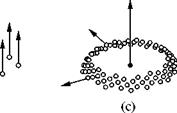The hydra component multiplies all components attached to the p-graph and places them in a star-shaped arrangement. With the hydra component, the user can define the number and size of successors, the opening angles of the star, and the turning of the successors with respect to the direction of the centerline. In Fig. 6.5a the centerlines of the father component and the multiplied components are shown.
The wreath component arranges its successors on a ring. Input parameters are its diameter as well as the number of successors.
![]() Phiball Component
Phiball Component
If components are multiplied by a Phiball component, then the geometries are generated according to the rule of the Golden Section on a spherical surface. The user enters the number and size of the components which can be multiplied as well as the opening angle of the sphere. This opening angle permits us to arrange the geometry also on a spherical section which makes the component usable in many applications. If only the cap of the sphere is needed, and if a large radius is entered, circular arrangements can be produced.
This technique is used, for example, with the sunflower seeds, in order to render these in their typical arrangement. A lateral cut through the sphere, as shown in Fig. 6.5c, can be applied for producing petals.
|
|
|
|
|





